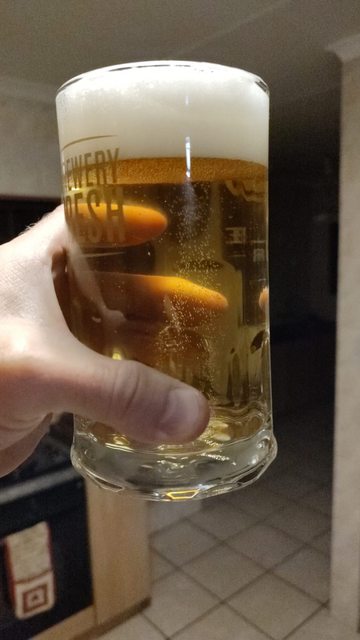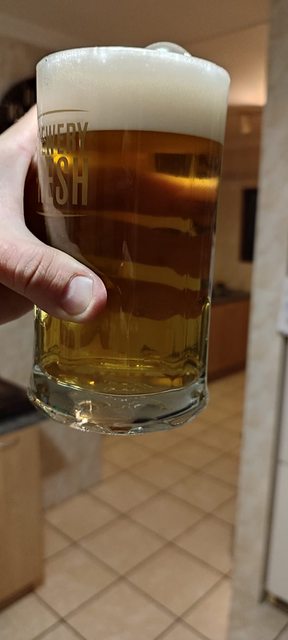Thank you very much for the detailed report on the comparison. I've witnessed the same when trying lutra. I used it in an apa type of recipe and the kveik taste was not such a big problem there. It was so little that I could totally see this yeast as an easy summer replacement for us05 if one doesn't have temperature control. But otherwise, I'd probably prefer a clean ale yeast.Alrighty, we're discharged just this morning. Over the weekend though I felt a bit better and tapped the kegs. Now, notes before I put out my first comments on the beers:
1. Both kegs have now been "lagering" for 4 weeks.
2. Both kegs were fined with the same amount of gelatin from the same pack, using the same method, at the same temperature and everything else the same, around 2 weeks ago.
3. Both kegs have been sitting at 17 PSI for 2 weeks now. Pressure in the two is absolutely identical, as they're connected to a single CO2 tank with a single regulator, just a gas line splitter between the two kegs.
4. I tapped around 250ml from both kegs to get the dregs out first, and after that the clear beer started flowing.
Now, onto the notes. First beer tested was the one fermented with Lutra:

First, clear, almost crystal at this point. The first thing that struck me was the definitive and instantly identifiable Kveik "rotten" aroma on the beer. It shined in the head, and it continued throughout the beer. This specific flavour vented off with time, as it did with other Kveik beers I made as well. It seems to be a characteristic of Kveiks as I've picked it up in Voss, Oslo and now again in Lutra as well. It's something I'm now expecting from Kveik.
Second, it is well carbonated. There are a stream of bubbles rising in the middle of the glass (where the glass is etched to entice bubbles forming inside to make it present better) and they rise fairly quickly. Head is thick and foamy. Lacing on the glass presented OK and head lasted all the way down to the last sip, which took about 30 minutes to get to (I got busy, and it's a big glass).
Next up, the flavour. There's definitely still a fruity aroma and flavour in the beer, albeit toned down after 4 weeks in the keg. It still hides the IBUs in the beer and the beer is not as bitter as I bittered it at. I'm not sure if it's the yeast flavour or the warm fermenting coupled with the aggressive venting of CO2 that pushed the hop flavour and aroma from the beer, but it's very subdued. The earthy, floral and almost spicy notes I hoped for are literally "earthy fruit" at this stage, and that's it.
Conclusion: It's a good beer. Not one of my best, but it's good and still very drinkable. It's got a fairly full mouthfeel and a creamy, almost oily texture to it that's hard to describe, and I'm not sure if it's the correct way to do so. Yeast presence is identifiable immediately and it's not as clean as they'd claim. At all. I would not use Lutra again to make a beer like this, but I think this yeast will do wonders in a NEIPA, for example.
The second beer was the one fermented with Diamond Lager:

First thing I noticed is that the beer is ever so slightly less clear than the Lutra batch. It's still clear, also almost crystal, but it seemed to have a tiny tiny slight haze to it. I'll do a side by side a bit later and take pictures of the two to compare properly, but this I did notice.
Second, it seems to be less carbonated than the Lutra batch. This has me stumped. I can't figure it out. As per my notes above, they should be identically carbonated, but they're not. It's still carbonated, but there are less bubbles, they rise slower and the beer seems to "hold on" to the CO2 in it better than the Lutra beer. Why? I can't tell you. Head was less but it still stuck around to the bottom of the glass, with decent (but fine) lacing. Head is also creamier than the Lutra beer's.
Then, flavour. This was interesting. Same wort, same everything, but the difference in yeast shined here. There seems to be a slight sour note which I expect to age out, but the hops are way more up front. IBUs jump out at you and the beer is fairly bitter (which I aimed for). There's earthy, floral and spicy hops everywhere, although I have to say I miss a bit of sweetness from the malt. I should have upped the dextrin, or used a light crystal malt for some added sweetness here, or mashed a bit higher, but eh, so you learn.
Conclusion: Diamond Lager does what it does. It's clean, it's clear, it's good. I love it and it's becoming a staple yeast of mine. That's about all there's to say about it.
Finally, as a last note, I'll repeat this test a few times in the next few months as the beers continue to improve in the keg, and I'll specifically aim for the flavours pointed out above to see how they react to age. Stay tuned!
PS: I think I should also do a side by side test in a video and post to YouTube. It's interesting to see.
And lutra compared to a lager yeast, completely different thing, I agree.



















![Craft A Brew - Safale BE-256 Yeast - Fermentis - Belgian Ale Dry Yeast - For Belgian & Strong Ales - Ingredients for Home Brewing - Beer Making Supplies - [3 Pack]](https://m.media-amazon.com/images/I/51bcKEwQmWL._SL500_.jpg)






































